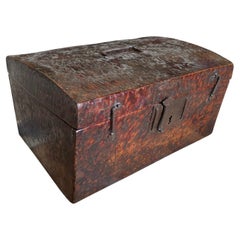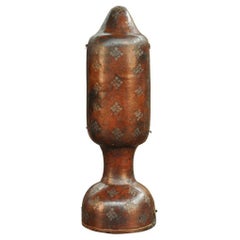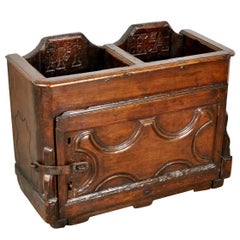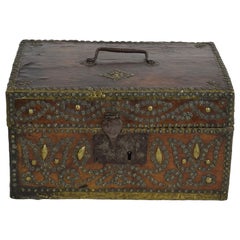Provenance Antiques Boxes
4
to
4
4
4
4
4
Height
to
Width
to
3
3
1
1
4
2
2
Exceptional French 17th Century Marriage Trunk
Located in Atlanta, GA
An exceptional 17th century Marriage Trunk - Malle - from the Provence region of France. Soundly constructed from wood and clad in leather. Beautifully ...
Category
Antique 17th Century French Trunks and Luggage
Materials
Leather
French 17th Century Leather Box, Coffre
Located in Atlanta, GA
A very charming late 17th century French Coffre - Box crafted from beautifully patina'd leather. A wonderful piece to serve as a jewelry box or to adorn any table top.
Category
Antique 17th Century French Decorative Boxes
Materials
Leather
17th Century Leather Case for a Chalice
Located in Atlanta, GA
A very rare and beautiful Italian 17th century case, box, to store a chalice. Beautifully crafted with embossed leather. A fantastic accent piece, whether displayed as a single piece...
Category
Antique Late 17th Century Italian Religious Items
Materials
Leather
Italian 17th Century Primitive Collection Box
Located in Atlanta, GA
A rare and unique church collection box from Northern Italy. Beautifully constructed from thick planks of walnut with intriguing carving detail. A wonde...
Category
Antique Mid-17th Century Italian Decorative Boxes
Materials
Walnut
Related Items
Small 17th Century, French Coffer or Box in Leather
Located in Buisson, FR
Extremely old box that is covered with leather and decorated with iron and brass.
Rare find.
France, circa 1600-1700
Weathered and some losses.
Category
Antique 17th Century French Decorative Boxes
Materials
Iron
17th Century English Leather Covered Knife Box Converted To a Letter Box
Located in San Francisco, CA
17th century leather knife box converted to a letter box with original brass hardware, sitting on brass ball feet.
Fitted interior lined with 18th century silk fabric.
In very good...
Category
Antique 17th Century European Decorative Boxes
Materials
Brass
Swedish 19th Century Painted Pine Marriage Trunk
Located in Baton Rouge, LA
A large 19th century iron bound painted marriage trunk. The exterior of this truck is painted blue with colorful flower baskets and arrangements on its facade with the monogram, “B S...
Category
Antique 19th Century Swedish Other Trunks and Luggage
Materials
Iron
English 19th Century Leather Trunk
Located in Baton Rouge, LA
We absolutely love this decorative trunk from England! Bound in perfectly worn dark leather and adorned with brass studs in swirling patterns. The lock is in working condition and in...
Category
Antique 19th Century English Chinese Export Decorative Boxes
Materials
Brass, Metal
Mid-20th Century Italian Leather Playing Card Case
Located in Stamford, CT
Wonderful Italian handcrafted tooled leather playing card case with painted enamel-like decoration of cards on the sides and symbols for all the suites, clubs, diamonds, spades and hearts on the cushion top. Beautifully made and clearly loved, a charming gift for the poker player or gambler. Holds two decks.
Stamped on the bottom in gold letters, 'Genuine Leather, Made in Italy'. With a fleur di lis mark stamped...
Category
Mid-20th Century Mid-Century Modern Decorative Boxes
Materials
Leather
Bronze Bassin for Holy Water, Spain, 17th Century
Located in Madrid, ES
Holy wall font. Bronze. Spain, 17th Century.
Small font for holy water designed to be placed on a wall, which has a container decorated with moldings and architectural elements and...
Category
Antique 17th Century Spanish Baroque Religious Items
Materials
Bronze, Other
Small 17th Century, French Coffer or Box in Leather
Located in Buisson, FR
Extremely old box that is covered with leather and metal decorations.
Rare find.
France, circa 1600-1700.
Weathered and some losses.
Category
Antique 17th Century French Decorative Boxes
Materials
Leather, Wood
Vintage Leather Cigar Case W. B Corter
Located in Oxfordshire, GB
Tan leather cigar case.
A fine leather cigar case inscribed in ink 'W.B. Corter. June 06'. A great usable item, will take maximum cigar diameter of...
Category
Vintage 1930s Tobacco Accessories
Materials
Leather
Small 17th Century, French Coffer or Box in Leather
Located in Buisson, FR
Extremely old box that is covered with leather and metal decorations.
Rare find.
France, circa 1600-1700
Weathered and some losses.
Category
Antique 17th Century French Decorative Boxes
Materials
Leather, Wood
Antique 17th Century Spanish Chestnut Carved Trunk or Chest
Located in Casteren, NL
A beautiful trunk or coffer from Northern Spain that was made in the first part of the 17th century.
It features a rectangular hinged molded top over a deeply carved base. The front...
Category
Antique Mid-17th Century Spanish Rustic Trunks and Luggage
Materials
Iron
19th Century Victorian Solid Silver Lighter & Vesta Case, London, c.1853
By Thornhill, Henry William Dee
Located in Royal Tunbridge Wells, Kent
Antique mid-19th Century very rare Victorian solid silver vesta case and lighter, in a shape of a horseshoe, opening on both sides, with a compartment for matches and a striker, with wheel to wind the lighter wick, one side is applied with initials "E.H". Hallmarked English Silver (925 standard), London, year 1853 (S), Maker's mark H.W.D (Henry William Dee...
Category
Antique 19th Century British Victorian Tobacco Accessories
Materials
Silver
Free Shipping
H 2.17 in W 2.17 in D 0.6 in
Boiled Leather Trunk, Spanish, 17th Century
Located in Bruxelles, BE
Leather trunk
Spanish, 17th century
Boiled Leather, wood and iron
Measures: 22 x 53 x 32 cm.
Provenance :
- collection Metz-Noblat, Château de Clevant, France
Rectangular trunk of the form and size of a small suitcase with wrought iron hinges and lock-plate.
Wood, covered with leather, cut and embossed with every surface of the thick cow hide covered in interlace, zoomorphic features.
The construction method is boiled leather, often referred to by its French translation cuir-bouilli: a process used to change flexible, vegetable-tanned leather into rigid, moulded objects. For shaping of the vegetable-tanned leather, heat and moisture were used, as indicated by the term boiled leather. No written medieval sources describing the production of decorated cuir bouilli objects survive, so knowledge of the process relies on the important studies of the Scottish leather historian John William Waterer. A large range of methods, materials and techniques could be used in various combinations. The vegetable-tanned leather, made supple with moisture and heat, was stuffed, shaped and nailed to the rigid wooden coffer support. The stuffing material was probably modeled beeswax or stearin wax. To shape the leather, to create its topography, « Cushions » were made by lacing a thread through an awl hole and attaching the flexible leather and stuffing to the rigid wooden support on the bottom. Then the decoration was done: lines were incised through the upper layer of the leather (epidermis) with different thicknesses of knives or needles. Contours were created with deep v-shaped cuts, decoration with thin incision and final details with a needle point. For the incision and pouncing stage, the leather was probably kept heated and moistened for suppleness.
Once dry, the leather would be hard and rigid.
the saturated leather is worked over a form, possibly even damp sand, with the pattern shaped using bone or wooden tools. Compare to metal, leather was lighter and it offered protection from cuts and punctures. Cuir bouilli objects were produced by specialist leather workers and needed skillful craftsmanship.
The surface is filled with roundels shaped foliages enclosing animals, lions and peacocks. The foliate arabesques creating a vegetal connection tweet the animals create the impression of a lush verdant space . The vegetal pattern here employed in combination with geometrical pattern came from the pre-islamic artistic traditions of the Byzantine and Sasanian empires. An aspect of Islamic geometry Is the basic symmetrical repetition and mirroring of the shapes that create a sense of harmony.
The decoration of this truck is inspired by the islamic « arabesque » a form of vegetal ornament composed of spirals, intertwining plants and abstract curvilinear motifs. An arabesque character is given to the birds of the decorations through extreme stylisation. This arabesque maintained the classical tradition of median symmetry, freedom in Detail and heterogeneity of ornament.
The presence of the peacocks is a paradisiacal allusion: in popular Islamic literature they were among the original inhabitants of the garden of Paradise expelled with Adam and Eve. Peacock as a decorative motif may have originated in the West, despite their eastern provenance. There was an ancient belief that the flesh and feathers of peacock do not decay. This led to the peacock becoming a christian symbol for Christ’s resurrection.
Renowned for their decorative wall hangings, seventeenth-century Spanish leatherworkers also produced utilitarian objects, such as this trunk. A similar trunk is on display at the Metropolitan museum of art ( 09.158.1).
Related literature :
Davies L. 2006. Cuir bouilli. Conservation of leather and related materials, 94-102, Oxford: elsevier Butterworth-Heinemann
Grabar, Oleg. The Mediation of Ornament. Princeton: Princeton University Press, 1992
Gabriela Germana Roquez, "El mueble en el Peru en el siglo XVIII...
Category
Antique 17th Century Decorative Boxes
Materials
Iron





